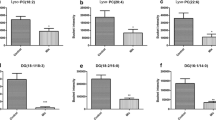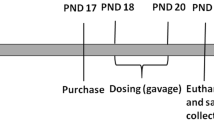Abstract
Humans are simultaneously exposed to several chemicals that act jointly to induce mixture effects. At doses close to or higher than no-observed adverse effect levels, chemicals usually act additively in experimental studies. However, we are lacking knowledge on the importance of exposure to complex real-world mixtures at more relevant human exposure levels. We hypothesised that adverse mixture effects occur at doses approaching high-end human exposure levels. A mixture (Mix) of 14 chemicals at a combined dose of 2.5 mg/kg bw/day was tested in combination with perfluorononanoic acid (PFNA) at doses of 0.0125 (Low PFNA), 0.25 (Mid PFNA) and 5 (High PFNA) mg/kg bw/day by oral administration for 14 days in juvenile male rats. Indication of a toxicokinetic interaction was found, as simultaneous exposure to PFNA and the Mix caused a 2.8-fold increase in plasma PFNA concentrations at Low PFNA. An increase in testosterone and dihydrotestosterone plasma concentrations was observed for Low PFNA + Mix. This effect was considered non-monotonic, as higher doses did not cause this effect. Reduced LH plasma concentrations together with increased androgen concentrations indicate a disturbed pituitary-testis axis caused by the 15-chemical mixture. Low PFNA by itself increased the corticosterone plasma concentration, an effect which was normalised after simultaneous exposure to Mix. This combined with affected ACTH plasma concentrations and down-regulation of 11β HSD mRNA in livers indicates a disturbed pituitary-adrenal axis. In conclusion, our data suggest that mixtures of environmental chemicals at doses approaching high-end human exposure levels can cause a hormonal imbalance and disturb steroid hormones and their regulation. These effects may be non-monotonic and were observed at low doses. Whether this reflects a more general phenomenon that should be taken into consideration when predicting human mixture effects or represents a rarer phenomenon remains to be shown.






Similar content being viewed by others
References
Ahlgrim C, Guglin M (2009) Anabolics and cardiomyopathy in a bodybuilder: case report and literature review. J Cardiac Fail 15(6):496–500. doi:10.1016/j.cardfail.2008.12.014
Bailey DG, Dresser GK, Bend JR (2003) Bergamottin, lime juice, and red wine as inhibitors of cytochrome P450 3A4 activity: comparison with grapefruit juice. Clin Pharmacol Ther 73(6):529–537. doi:10.1016/S0009-9236(03)00051-1
Bailey DG, Spence JD, Edgar B, Bayliff CD, Arnold JM (1989) Ethanol enhances the hemodynamic effects of felodipine. Clin Invest Med 12(6):357–362
CDC (2009) Fourth national report on human exposure to environmental chemicals. Department of health and human services centers for disease control and prevention
Cerrutti JA, Brandoni A, Quaglia NB, Torres AM (2002) Sex differences in p-aminohippuric acid transport in rat kidney: role of membrane fluidity and expression of OAT1. Mol Cell Biochem 233(1–2):175–179. doi:10.1023/A:1015563021602
Cheng KC, Schenkman JB (1983) Testosterone metabolism by cytochrome P-450 isozymes RLM3 and RLM5 and by microsomes. Metabolite identification. J Biol Chem 258(19):11738–11744
Christiansen S, Kortenkamp A, Axelstad M et al (2012) Mixtures of endocrine disrupting contaminants modelled on human high end exposures: an exploratory study in rats. Int J Androl 35(3):303–316. doi:10.1111/j.1365-2605.2011.01242.x
Crofton KM, Craft ES, Hedge JM et al (2005) Thyroid-hormone-disrupting chemicals: evidence for dose-dependent additivity or synergism. Environ Health Perspect 113(11):1549–1554
Demur C, Metais B, Canlet C et al (2013) Dietary exposure to a low dose of pesticides alone or as a mixture: the biological metabolic fingerprint and impact on hematopoiesis. Toxicology 308:74–87. doi:10.1016/j.tox.2013.03.004
Emmett EA, Shofer FS, Zhang H, Freeman D, Desai C, Shaw LM (2006) Community exposure to perfluorooctanoate: relationships between serum concentrations and exposure sources. J Occup Environ Med/American College of Occupational and Environmental Medicine 48(8):759–770. doi:10.1097/01.jom.0000232486.07658.74
Fang X, Feng Y, Wang J, Dai J (2010) Perfluorononanoic acid-induced apoptosis in rat spleen involves oxidative stress and the activation of caspase-independent death pathway. Toxicology 267(1–3):54–59. doi:10.1016/j.tox.2009.10.020
Feng Y, Shi Z, Fang X, Xu M, Dai J (2009) Perfluorononanoic acid induces apoptosis involving the Fas death receptor signaling pathway in rat testis. Toxicol Lett 190(2):224–230. doi:10.1016/j.toxlet.2009.07.020
Foti RS, Wahlstrom JL (2008) The role of dietary supplements in cytochrome P450-mediated drug interactions. Bol Latinoam Caribe 7(2):66–84
Fuhrman B, Buch S, Vaya J et al (1997) Licorice extract and its major polyphenol glabridin protect low-density lipoprotein against lipid peroxidation: in vitro and ex vivo studies in humans and in atherosclerotic apolipoprotein E-deficient mice. Am J Clin Nutr 66(2):267–275
Guengerich FP (1999) Cytochrome P-450 3A4: regulation and role in drug metabolism. Annu Rev Pharmacol Toxicol 39:1–17. doi:10.1146/annurev.pharmtox.39.1.1
Hadrup N, Loeschner K, Bergstrom A et al (2012) Subacute oral toxicity investigation of nanoparticulate and ionic silver in rats. Arch Toxicol 86(4):543–551
Hadrup N, Petersen JS, Windfeld S et al (2007) Differential down-regulation of aquaporin-2 in rat kidney zones by peripheral nociceptin/orphanin FQ receptor agonism and vasopressin type-2 receptor antagonism. J Pharmacol Exp Ther 323(2):516–524
Hadrup N, Taxvig C, Pedersen M, Nellemann C, Hass U, Vinggaard AM (2013) Concentration addition, independent action and generalized concentration addition models for mixture effect prediction of sex hormone synthesis in vitro. PLoS One 8(8):e70490. doi:10.1371/journal.pone.0070490
Han X, Nabb DL, Russell MH, Kennedy GL, Rickard RW (2012) Renal elimination of perfluorocarboxylates (PFCAs). Chem Res Toxicol 25(1):35–46. doi:10.1021/Tx200363w
Hass U, Scholze M, Christiansen S et al (2007) Combined exposure to anti-androgens exacerbates disruption of sexual differentiation in the rat. Environ Health Perspect 115(Suppl 1):122–128
Karmaus W, Osuch JR, Landgraf J, Taffe B, Mikucki D, Haan P (2011) Prenatal and concurrent exposure to halogenated organic compounds and gene expression of CYP17A1, CYP19A1, and oestrogen receptor alpha and beta genes. Occup Environ Med 68(6):430–437. doi:10.1136/oem.2009.053249
Kent UM, Aviram M, Rosenblat M, Hollenberg PF (2002) The licorice root derived isoflavan glabridin inhibits the activities of human cytochrome P450S 3A4, 2B6, and 2C9. Drug Metab Dispos 30(6):709–715
Kenworthy KE, Bloomer JC, Clarke SE, Houston JB (1999) CYP3A4 drug interactions: correlation of 10 in vitro probe substrates. Br J Clin Pharmacol 48(5):716–727
Kortenkamp A (2014) Low dose mixture effects of endocrine disrupters and their implications for regulatory thresholds in chemical risk assessment. Curr Opin Pharmacol 19C:105–111. doi:10.1016/j.coph.2014.08.006
Kudo N, Katakura M, Sato Y, Kawashima Y (2002) Sex hormone-regulated renal transport of perfluorooctanoic acid. Chem-Biol Interact 139(3):301–316. doi:10.1016/S0009-2797(02)00006-6
Lau C, Anitole K, Hodes C, Lai D, Pfahles-Hutchens A, Seed J (2007) Perfluoroalkyl acids: a review of monitoring and toxicological findings. Toxicol Sci 99(2):366–394. doi:10.1093/toxsci/kfm128
Lim HK, Duczak N Jr, Brougham L, Elliot M, Patel K, Chan K (2005) Automated screening with confirmation of mechanism-based inactivation of CYP3A4, CYP2C9, CYP2C19, CYP2D6, and CYP1A2 in pooled human liver microsomes. Drug Metab Dispos 33(8):1211–1219. doi:10.1124/dmd.104.003475
Ljubojevic M, Herak-Kramberger CM, Hagos Y et al (2004) Rat renal cortical OAT1 and OAT3 exhibit gender differences determined by both androgen stimulation and estrogen inhibition. Am J Physiol Renal 287(1):F124–F138. doi:10.1152/ajprenal.00029.2004
Lu R, Kanai N, Bao Y, Wolkoff AW, Schuster VL (1996) Regulation of renal oatp mRNA expression by testosterone. Am J Physiol Renal Fluid Electrolyte Physiol 270(2):F332–F337
Martignoni M, Groothuis GM, de Kanter R (2006) Species differences between mouse, rat, dog, monkey and human CYP-mediated drug metabolism, inhibition and induction. Expert Opin Drug Metab Toxicol 2(6):875–894. doi:10.1517/17425255.2.6.875
McGinnis MY (2004) Anabolic androgenic steroids and aggression: studies using animal models. Ann N Y Acad Sci 1036:399–415. doi:10.1196/annals.1330.024
Merhi M, Demur C, Racaud-Sultan C et al (2010) Gender-linked haematopoietic and metabolic disturbances induced by a pesticide mixture administered at low dose to mice. Toxicology 267(1–3):80–90. doi:10.1016/j.tox.2009.10.024
Mortensen SK, Pedersen M (2007) Confirmatory analysis of acetylgestagens in plasma using liquid chromatography-tandem mass spectrometry. Anal Chim Acta 586(1–2):217–222
Reagan-Shaw S, Nihal M, Ahmad N (2008) Dose translation from animal to human studies revisited. FASEB J 22(3):659–661. doi:10.1096/fj.07-9574LSF
Schmittgen TD, Livak KJ (2008) Analyzing real-time PCR data by the comparative C(T) method. Nat Protoc 3(6):1101–1108
Sigurjonsdottir HA, Franzson L, Manhem K, Ragnarsson J, Sigurdsson G, Wallerstedt S (2001) Liquorice-induced rise in blood pressure: a linear dose-response relationship. J Hum Hypertens 15(8):549–552. doi:10.1038/sj.jhh.1001215
Silva E, Rajapakse N, Kortenkamp A (2002) Something from “nothing”–eight weak estrogenic chemicals combined at concentrations below NOECs produce significant mixture effects. Environ Sci Technol 36(8):1751–1756
Stanko JP, Enoch RR, Rayner JL et al (2010) Effects of prenatal exposure to a low dose atrazine metabolite mixture on pubertal timing and prostate development of male Long-Evans rats. Reprod Toxicol 30(4):540–549. doi:10.1016/j.reprotox.2010.07.006
Tassaneeyakul W, Guo LQ, Fukuda K, Ohta T, Yamazoe Y (2000) Inhibition selectivity of grapefruit juice components on human cytochromes P450. Arch Biochem Biophys 378(2):356–363. doi:10.1006/abbi.2000.1835
Tatum-Gibbs K, Wambaugh JF, Das KP et al (2011) Comparative pharmacokinetics of perfluorononanoic acid in rat and mouse. Toxicology 281(1–3):48–55. doi:10.1016/j.tox.2011.01.003
Thomson LM, Raven PW, Smith KE, Hinson JP (1998) Effects of metyrapone on hepatic cortisone-cortisol conversion in the rat. Endocr Res 24(3–4):607–611
Tian M, Yan H, Row KH (2008) Extraction of glycyrrhizic acid and glabridin from licorice. Int J Mol Sci 9(4):571–577
Uesawa Y, Mohri K (2006) The use of heat treatment to eliminate drug interactions due to grapefruit juice. Biol Pharm Bull 29(11):2274–2278
US_Environmental_Protection_Agency (2014) Interactive chemical safety for sustainability (iCSS) dashboard. http://actor.epa.gov/dashboard/. Accessed 20 March 2014
Vogeli I, Jung HH, Dick B et al (2013) Evidence for a role of sterol 27-hydroxylase in glucocorticoid metabolism in vivo. J Endocrinol 219(2):119–129. doi:10.1530/JOE-13-0141
Wade MG, Foster WG, Younglai EV et al (2002) Effects of subchronic exposure to a complex mixture of persistent contaminants in male rats: systemic, immune, and revoductive effects. Toxicol Sci 67(1):131–143. doi:10.1093/toxsci/67.1.131
Wen YH, Sahi J, Urda E et al (2002) Effects of bergamottin on human and monkey drug-metabolizing enzymes in primary cultured hepatocytes. Drug Metab Dispos 30(9):977–984
Yamazaki H, Shimada T (1997) Progesterone and testosterone hydroxylation by cytochromes P450 2C19, 2C9, and 3A4 in human liver microsomes. Arch Biochem Biophys 346(1):161–169. doi:10.1006/abbi.1997.0302
Yang C, Tan YS, Harkema JR, Haslam SZ (2009a) Differential effects of peripubertal exposure to perfluorooctanoic acid on mammary gland development in C57Bl/6 and Balb/c mouse strains. Reprod Toxicol 27(3–4):299–306. doi:10.1016/j.reprotox.2008.10.003
Yang CH, Glover KP, Han X (2009b) Organic anion transporting polypeptide (Oatp) 1a1-mediated perfluorooctanoate transport and evidence for a renal reabsorption mechanism of Oatp1a1 in renal elimination of perfluorocarboxylates in rats. Toxicol Lett 190(2):163–171. doi:10.1016/j.toxlet.2009.07.011
Acknowledgments
Excellent technical assistance was provided by Anne Ørngreen, Maja Danielsen, Eva Ferdinansen, Elise E. Navntoft, Eigil V. Frank, Kenneth R. Worm, Kitt Lademann, Lis Abildgaard Andersen, Birgitte Møller Plesning, Liljana Petrevska, Heidi Letting and Dorte Lykkegaard Korsbech. The Ministry of Food, Agriculture and Fisheries of Denmark and the Danish Veterinary and Food Administration are acknowledged for their financial support.
Conflict of interest
The authors declare that there are no conflicts of interest.
Author information
Authors and Affiliations
Corresponding author
Rights and permissions
About this article
Cite this article
Hadrup, N., Pedersen, M., Skov, K. et al. Perfluorononanoic acid in combination with 14 chemicals exerts low-dose mixture effects in rats. Arch Toxicol 90, 661–675 (2016). https://doi.org/10.1007/s00204-015-1452-6
Received:
Accepted:
Published:
Issue Date:
DOI: https://doi.org/10.1007/s00204-015-1452-6




